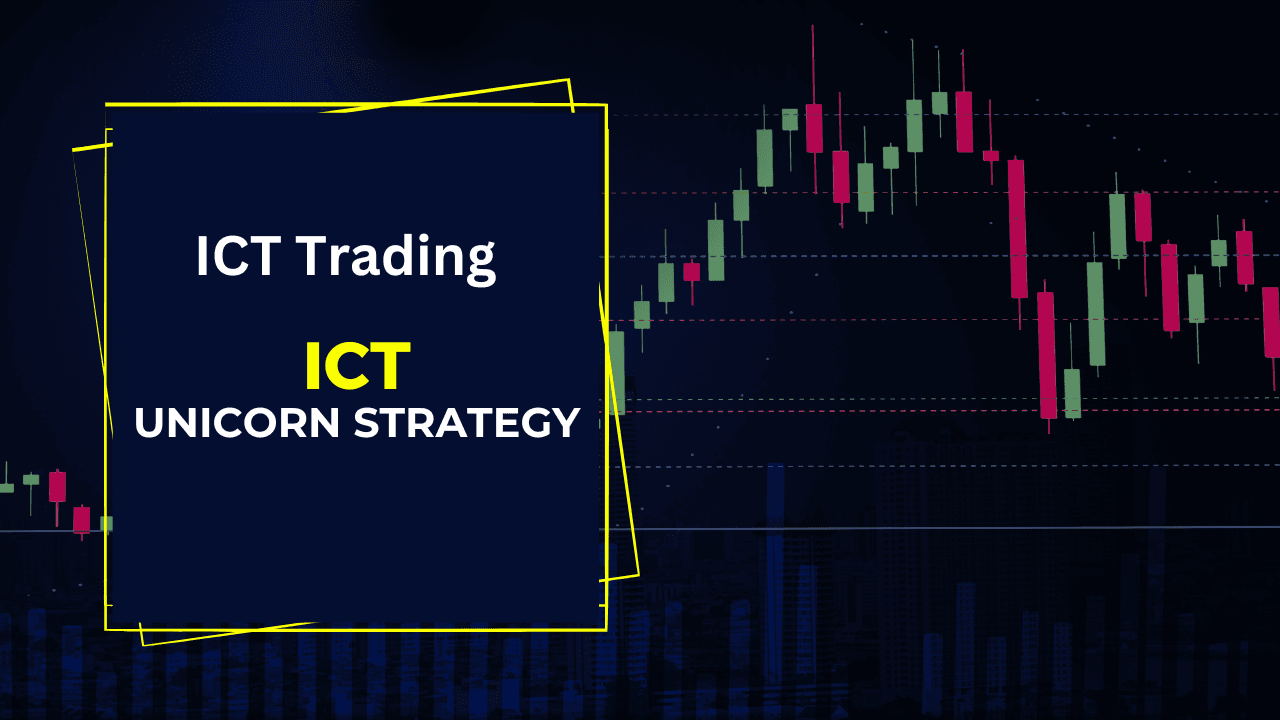In the world of Inner Circle Trading (ICT), the Unicorn Strategy stands out as a powerful method designed to enhance precision and accuracy in market analysis. This strategy leverages ICT’s core principles, focusing on identifying high-probability setups by analyzing market structure, liquidity, and price movements. Traders who master the ICT Unicorn Strategy gain an edge by entering trades with confidence, managing risks effectively, and securing better returns. In this article, we will dive deep into the mechanics of the Unicorn Strategy, exploring its key components and how you can use it to improve your trading success.
Introduction to ICT Unicorn Strategy
The ICT Unicorn Strategy is a method that aligns with the core principles of Inner Circle Trading (ICT), which focuses on reading the market’s internal dynamics to pinpoint high-probability trade setups. This strategy leverages market structure, liquidity levels, and price behavior to ensure traders make calculated decisions when entering or exiting positions.
In essence, the ICT Unicorn Strategy helps traders reduce risks while capitalizing on market inefficiencies. The Unicorn Strategy’s objective is to allow traders to anticipate significant market movements based on key market phases and price shifts.
By understanding how the market operates, traders can avoid common pitfalls such as false breakouts and incorrect market entries. The Unicorn Strategy teaches traders how to interpret the order flow in the market and use it to their advantage. As a result, traders who master the ICT Unicorn Strategy are able to make better, more informed decisions, improving their overall trading performance.
Understanding the Core Concepts of ICT
To fully grasp the ICT Unicorn Strategy, it is essential to understand the core concepts of Inner Circle Trading (ICT). These concepts form the foundation upon which the Unicorn Strategy is built and are key to identifying profitable opportunities in the market.
Market Structure
Market structure refers to the way in which price movements unfold on the charts. It is crucial to identify whether the market is in a bullish, bearish, or consolidating phase. By understanding market structure, traders can determine the trend and potential reversal points, which are key for making precise trade entries.
The ICT Unicorn Strategy uses market structure to help traders identify when the market is likely to shift direction, allowing them to either take advantage of the trend or anticipate a reversal.
Liquidity
Liquidity refers to the availability of orders in the market. Markets move in search of liquidity, and ICT traders often focus on liquidity pools to predict where price is likely to move next. Liquidity zones can be found near previous highs and lows, as well as around significant support and resistance levels.
In the context of the ICT Unicorn Strategy, liquidity plays a critical role in defining entry and exit points. Traders use liquidity pools to gauge when large market players, such as institutions, may move the market, helping them position their trades accordingly.
Bias
Bias refers to the directional expectation a trader has for the market. Having a strong directional bias means that you expect the market to move either upward or downward. This bias is developed based on an understanding of market structure and liquidity.
The ICT Unicorn Strategy emphasizes forming a clear bias based on the current market conditions. By developing a strong directional bias, traders can make informed decisions that are aligned with the market’s overall direction.
Key Components of the ICT Unicorn Strategy
The ICT Unicorn Strategy is built upon several key components that guide traders in making informed decisions. Understanding these components is critical to effectively utilizing the strategy. Below are the core elements that make the ICT Unicorn Strategy highly reliable for finding high-probability trade setups:
Market Phases and Cycles
The market operates in cycles, moving through phases such as accumulation, markup, distribution, and markdown. The ICT Unicorn Strategy teaches traders to identify these market phases and take advantage of them. For example, during the accumulation phase, large market players accumulate positions, causing price consolidation. In the markup phase, prices move higher, and traders using the ICT Unicorn Strategy can ride the trend to secure profits.
By understanding where the market is in its cycle, traders can identify the best times to enter and exit trades, improving overall profitability.
Identifying Optimal Entry and Exit Points
One of the key strengths of the ICT Unicorn Strategy is its ability to pinpoint optimal entry and exit points. Using market structure and liquidity pools, traders can determine when to enter a trade to capitalize on price inefficiencies. This ensures that trades are entered with a higher probability of success.
For entry points, traders wait for the market to demonstrate a clear directional bias and identify areas of liquidity that the price is likely to move toward. For exits, the strategy focuses on capturing profits at key support and resistance levels, avoiding overexposure to unnecessary risk.
Risk Management in the ICT Unicorn Strategy
Effective risk management is central to the ICT Unicorn Strategy. Even with a highly precise strategy, it is important to protect your capital by limiting the size of losses. The strategy emphasizes using stop-loss orders at key points to avoid large drawdowns. Additionally, the risk-to-reward ratio is carefully monitored to ensure that traders only take trades with a high potential for profit relative to the risk.
Traders should aim for at least a 1:2 or 1:3 risk-to-reward ratio to maximize their profitability and keep losses minimal. Consistent risk management is what separates professional traders from amateurs, and the ICT Unicorn Strategy helps traders maintain this discipline.
How to Use the ICT Unicorn Strategy
Now that the components of the ICT Unicorn Strategy are clear, let’s look at how to apply this method to your trading.
Step-by-Step Guide to Using the ICT Unicorn Strategy
- Analyze Market Structure: Start by identifying the current market structure. Is the market trending or consolidating? Use higher timeframes (daily or 4H) to get a broad view, then drill down to lower timeframes (1H, 15M) for precise entry points.
- Identify Liquidity Pools: Look for areas where the market is likely to target liquidity. These can be previous highs and lows, order blocks, or support and resistance zones. The price often seeks these levels before making a significant move.
- Develop a Bias: Based on the market structure and liquidity analysis, form a directional bias. Are you expecting a bullish or bearish move? Stick to your bias unless the market provides clear signals of a reversal.
- Wait for Confirmation: The ICT Unicorn Strategy advises waiting for price confirmation before entering a trade. This could be a break of structure, a change of character, or price retesting a key liquidity level.
- Enter the Trade: Once the market confirms your bias, enter the trade at an optimal point. Use limit orders near areas of liquidity or market orders if confirmation is clear.
- Set Stop Loss and Target Levels: Always place your stop-loss at a level that invalidates your trade idea (e.g., beyond the previous swing high or low). Set take-profit levels based on key support/resistance zones or liquidity targets.
- Monitor the Trade: Watch how the market reacts to liquidity zones and manage the trade accordingly. If the market is approaching your target, consider securing partial profits.
Practical Example of the ICT Unicorn Strategy in Action
Suppose you’re trading a bullish trend on a 4-hour timeframe. You observe that the market has created a swing low, indicating potential accumulation. After the market breaks a key resistance level, you notice a pool of buy-side liquidity just above the previous high. You wait for the price to retrace, targeting the liquidity level.
Once the market retests the support zone and confirms the bullish bias, you enter a long trade, placing your stop loss below the recent swing low. Your target is set at a higher resistance level, maximizing your profit while keeping your risk in check.
Advantages of the ICT Unicorn Strategy
The ICT Unicorn Strategy offers several advantages for traders who are looking to improve their precision in entering and exiting trades. Below are some of the key benefits that make this strategy highly effective in Inner Circle Trading (ICT).
High-Probability Trade Setups
One of the primary advantages of the ICT Unicorn Strategy is its focus on identifying high-probability trade setups. By analyzing market structure, liquidity levels, and price action, traders can filter out low-quality trades and focus only on those that offer the best potential for success. This reduces the likelihood of falling into common market traps such as false breakouts or choppy price action.
Precision in Entry and Exit Points
The strategy’s emphasis on precise entry and exit points allows traders to maximize their profit potential while minimizing risk. By targeting liquidity pools and using support and resistance zones, the ICT Unicorn Strategy helps traders enter trades when the odds are in their favor. This precision reduces drawdowns and increases overall trading efficiency.
Improved Risk-to-Reward Ratios
A well-known benefit of the ICT Unicorn Strategy is its focus on maintaining a favorable risk-to-reward ratio. Traders using this strategy typically aim for a 1:2 or even 1:3 risk-to-reward ratio, meaning the potential reward is two to three times greater than the risk. This ensures that even with a lower win rate, traders can remain profitable over the long term.
Consistency and Discipline
The ICT Unicorn Strategy promotes consistent trading by following a set of well-defined rules. It encourages traders to wait for price confirmation, only taking trades when the setup is aligned with their bias. This level of discipline helps traders avoid emotional decision-making, leading to more consistent results.
Adaptability Across Market Conditions
Another advantage of the ICT Unicorn Strategy is its adaptability across different market conditions. Whether the market is trending, consolidating, or experiencing volatility, this strategy provides traders with tools to navigate any environment. The focus on market phases and liquidity targeting allows traders to adjust their approach based on real-time market dynamics.
Common Mistakes to Avoid
While the ICT Unicorn Strategy is highly effective, there are common mistakes that traders should avoid to maximize its potential. Below are some of the most frequent errors and how to steer clear of them.
Over-Leveraging Positions
One of the biggest mistakes traders make is over-leveraging their trades, taking on too much risk relative to their account size. Although the ICT Unicorn Strategy focuses on high-probability trades, no strategy is foolproof. Over-leveraging can lead to significant losses, even with a solid trading plan. It’s important to only risk a small percentage of your capital on each trade, typically around 1-2%.
Ignoring Market Structure Shifts
Another common error is ignoring market structure shifts. The market is constantly changing, and failing to adapt your trading bias when the structure changes can lead to poor trade decisions. For instance, if you are in a bullish trend but the market suddenly breaks support levels and starts showing signs of bearishness, it’s important to reassess your bias and adjust accordingly.
Chasing the Market
Chasing the market refers to entering trades impulsively without a clear plan. This often happens when traders see a sudden price movement and rush into the trade without proper confirmation. The ICT Unicorn Strategy emphasizes waiting for confirmation before entering a trade, so it’s important to stick to your rules and avoid chasing after price.
Failing to Manage Risk
A major pitfall for traders is neglecting risk management. Even when using a precise strategy like the ICT Unicorn Strategy, it’s crucial to set proper stop-loss levels and adhere to your risk-to-reward ratio. Failing to manage risk properly can lead to significant losses, even if the majority of your trades are successful.
Tools and Indicators to Support ICT Unicorn Strategy
To effectively implement the ICT Unicorn Strategy, traders can benefit from using specific tools and indicators that enhance market analysis and improve trading precision. Below are some essential tools and indicators that can help traders leverage the Unicorn Strategy more effectively.
Charting Software
A reliable charting software is fundamental for any trader, as it allows for detailed market analysis. Look for platforms that offer advanced charting features, such as:
- Customizable indicators: To tailor your analysis according to your trading style.
- Multiple timeframe analysis: To view market structure across different timeframes, which is crucial for identifying trends and reversals.
- Drawing tools: To mark key support and resistance levels, liquidity pools, and market phases.
Fibonacci Retracement Tool
The Fibonacci Retracement tool is invaluable for identifying potential reversal levels in the market. By applying Fibonacci levels to significant price swings, traders can pinpoint areas of interest where price may react, helping to define entry and exit points. This tool is particularly useful when combined with other forms of technical analysis.
Volume Indicators
Understanding volume is essential for assessing the strength of price movements. Volume indicators, such as the Volume Weighted Average Price (VWAP) and On-Balance Volume (OBV), can help traders confirm the validity of a price move. High volume accompanying a breakout may indicate a stronger likelihood of continuation, while low volume may suggest a potential reversal.
Moving Averages
Moving averages, such as the Simple Moving Average (SMA) and Exponential Moving Average (EMA), can be useful for determining the overall market trend and potential reversal points. They help smooth out price fluctuations and can serve as dynamic support or resistance levels. For the ICT Unicorn Strategy, incorporating moving averages can enhance trend identification and entry timing.
Oscillators
Oscillators like the Relative Strength Index (RSI) and Stochastic Oscillator provide insight into market momentum and overbought or oversold conditions. These indicators can help traders identify potential reversal points when used in conjunction with the ICT Unicorn Strategy. For example, if the RSI indicates that the market is overbought while approaching a liquidity pool, it may be an excellent opportunity to consider an entry point for a short position.
Conclusion
The ICT Unicorn Strategy is a powerful trading method that empowers traders to identify high-probability trade setups through precise analysis of market structure, liquidity, and price action. By understanding the key components of this strategy and avoiding common mistakes, traders can improve their decision-making and enhance overall trading performance.
Utilizing the right tools and indicators, such as advanced charting software, Fibonacci retracement, volume indicators, moving averages, and oscillators, can further support the effective application of the ICT Unicorn Strategy. These tools help traders make informed decisions, allowing them to enter and exit trades with greater accuracy.
Incorporating the ICT Unicorn Strategy into your trading routine may lead to more consistent and profitable results. Remember to maintain discipline, practice proper risk management, and continually refine your skills to succeed in the dynamic world of Inner Circle Trading (ICT).
Read More Unlocking the ICT Power of 3
Frequently Asked Questions
What is the ICT Unicorn Strategy?
The ICT Unicorn Strategy is a trading approach developed within the framework of Inner Circle Trading (ICT). It focuses on identifying high-probability trade setups by analyzing market structure, liquidity, and price action. The strategy emphasizes precise entry and exit points, effective risk management, and adherence to a disciplined trading process.
How do I start using the ICT Unicorn Strategy?
- Learn the key concepts of market structure, liquidity, and price action.
- Set up a trading plan that includes your risk management rules.
- Use reliable charting software and familiarize yourself with tools like Fibonacci retracement, volume indicators, and moving averages.
- Practice analyzing the market to identify high-probability trade setups based on the strategy’s principles.
- Implement the strategy in a demo account before trading with real money.
What are the advantages of the ICT Unicorn Strategy?
- High-probability trade setups that increase the chances of success.
- Precision in entry and exit points, reducing risk and maximizing profit potential.
- Improved risk-to-reward ratios for long-term profitability.
- A focus on discipline and consistency in trading decisions.
- Adaptability across different market conditions.
What tools and indicators should I use with the ICT Unicorn Strategy?
- Charting software for advanced market analysis.
- Fibonacci retracement tool for identifying potential reversal levels.
- Volume indicators like VWAP and OBV to assess the strength of price movements.
- Moving averages for determining trends and potential reversal points.
- Oscillators such as RSI and Stochastic Oscillator to gauge market momentum.


